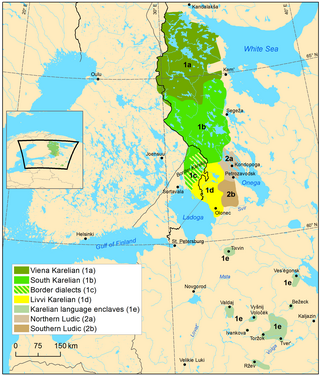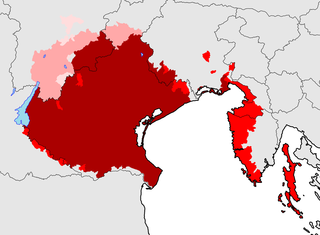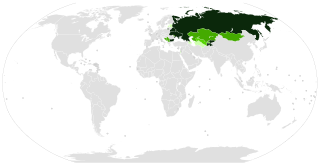Related Research Articles
Estonian is a Uralic language belonging to the Finnic branch of the family and the official language of Estonia. It is written in the Latin script and is the first language of the majority of the country's population; it is also an official language of the European Union. Estonian is spoken natively by about 1.1 million people: 922,000 people in Estonia and 160,000 elsewhere.
Sibilants are fricative consonants of higher amplitude and pitch, made by directing a stream of air with the tongue towards the teeth. Examples of sibilants are the consonants at the beginning of the English words sip, zip, ship, and genre. The symbols in the International Phonetic Alphabet used to denote the sibilant sounds in these words are, respectively,. Sibilants have a characteristically intense sound, which accounts for their paralinguistic use in getting one's attention.

Karelian is a Finnic language spoken mainly in the Russian Republic of Karelia. Linguistically, Karelian is closely related to the Finnish dialects spoken in eastern Finland, and some Finnish linguists have even classified Karelian as a dialect of Finnish, though in the modern day it is widely considered a separate language. Karelian is not to be confused with the Southeastern dialects of Finnish, sometimes referred to as karjalaismurteet in Finland. In the Russian 2020–2021 census, around 9,000 people spoke Karelian natively, but around 14,000 said to be able to speak the language.

The Samoyedic or Samoyed languages are spoken around the Ural Mountains, in northernmost Eurasia, by approximately 25,000 people altogether. They derive from a common ancestral language called Proto-Samoyedic, and form a branch of the Uralic languages. Having separated perhaps in the last centuries BC, they are not a diverse group of languages, and are traditionally considered to be an outgroup, branching off first from the other Uralic languages.

Venetian, wider Venetian or Venetan is a Romance language spoken natively in the northeast of Italy, mostly in Veneto, where most of the five million inhabitants can understand it. It is sometimes spoken and often well understood outside Veneto: in Trentino, Friuli, the Julian March, Istria, and some towns of Slovenia, Dalmatia (Croatia) and Bay of Kotor (Montenegro) by a surviving autochthonous Venetian population, and in Argentina, Australia, Brazil, Canada, Mexico, the United States and the United Kingdom by Venetians in the diaspora.

Herero (Otjiherero) is a Bantu language spoken by the Herero and Mbanderu peoples in Namibia and Botswana, as well as by small communities of people in southwestern Angola. There were 250,000 speakers in these countries between 2015 and 2018.
Berta proper, a.k.a. Gebeto, is spoken by the Berta in Sudan and Ethiopia. As of 2006 Berta had approximately 180,000 speakers in Sudan.

Kamasins were a collection of tribes of Samoyedic peoples in the Sayan Mountains who lived along the Kan River and Mana River in the 17th century in the southern part of today's Krasnoyarsk Krai.

Mator or Motor was a Uralic language belonging to the group of Samoyedic languages, extinct since the 1840s. It was spoken in the northern region of the Sayan Mountains in Siberia, close to the Mongolian north border. The speakers of Mator, Motorians or Motors, lived in a wide area from the eastern parts of the Minusinsk District (okrug) along the Yenisei River to the region of Lake Baikal. Three dialects of Mator were recorded: Mator proper as well as Taygi and Karagas. Mator was influenced by Mongolic, Tungusic and Turkic languages before it went extinct, and may have even been possibly influenced by the Iranic languages.
Meru is a Bantu language spoken by the Meru people (Ameru) who live on the Eastern and Northern slopes of Mount Kenya and on the Nyambene ranges. They settled in this area after centuries of migration from the north.

J, or j, is the tenth letter of the Latin alphabet, used in the modern English alphabet, the alphabets of other western European languages and others worldwide. Its usual name in English is jay, with a now-uncommon variant jy.
The Oghuric, Onoguric or Oguric languages are a branch of the Turkic language family. The only extant member of the group is the Chuvash language. The first to branch off from the Turkic family, the Oghuric languages show significant divergence from other Turkic languages, which all share a later common ancestor. Languages from this family were spoken in some nomadic tribal confederations, such as those of the Onogurs or Ogurs, Bulgars and Khazars.

Numerous Cyrillic alphabets are based on the Cyrillic script. The early Cyrillic alphabet was developed in the 9th century AD and replaced the earlier Glagolitic script developed by the theologians Cyril and Methodius. It is the basis of alphabets used in various languages, past and present, Slavic origin, and non-Slavic languages influenced by Russian. As of 2011, around 252 million people in Eurasia use it as the official alphabet for their national languages. About half of them are in Russia. Cyrillic is one of the most-used writing systems in the world. The creator is Saint Clement of Ohrid from the Preslav literary school in the First Bulgarian Empire.
The Koibal are one of the subdivisions of the Khakass people of Southern Siberia. Although they speak the Turkic Khakas language, the Koibal have mixed ancestry and used to speak the Koibal dialect of the Kamas language, which is now extinct. They formed in the late 19th century from the merger of the Abugach, Baikot, Kandyk, Tarazhak, Kol and Arsh peoples. Most of these people are believed to have been of ancestry more closely related to Samoyedic peoples than to Turkics. Koibals live in the Beysky District of Khakassia.
Koibal language may refer to:

Finnish is a Uralic language of the Finnic branch, spoken by the majority of the population in Finland and by ethnic Finns outside of Finland. Finnish is one of the two official languages of Finland. In Sweden, both Finnish and Meänkieli are official minority languages. The Kven language, which like Meänkieli is mutually intelligible with Finnish, is spoken in the Norwegian counties Troms and Finnmark by a minority group of Finnish descent.
Dargwa is a Northeast Caucasian language spoken by the Dargin people in the Russian republic Dagestan. It is the literary and main dialect of the dialect continuum constituting the Dargin languages.
Koibal may refer to:
The Nasu language, also known as the Eastern Yi language or Naisu, Luquan Yi, Wuding Yi, Guizhou Yi, Weining Yi, Guangxi Yi or Longlin Yi, is a Loloish language spoken by the Yi people of China. Nasu and Wusa are two of six Yi languages recognized by the Government of China. There are also some speakers in Vietnam. Unlike most written Yi languages, Nasu uses the Pollard script. A distinct form of the Yi script was traditionally used for Wusa, though few can still read it.
References
- 1 2 3 Tamás, Janurik. "[SW-3] Kojbál szótár: a publikált szójegyzékek egyesített szótára". Segédanyagok a déli-szamojéd nyelvek szókészletének tanulmányozásához III. Budenz Alkotóház. Székesfehérvár 2021, 161 p.
- ↑ "Кюннап - Койбальский язык". www.philology.ru. Retrieved 2021-05-13.
- ↑ Gerson, Klumpp. Kamas. University of Tartu.
